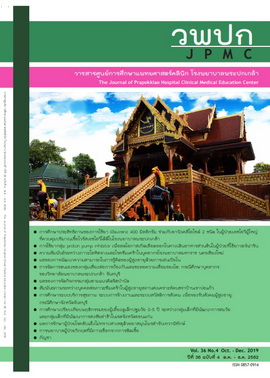A comparative study of preschool children between 0-5 years old children with developmental groups and groups of children with suspected developmental delays in KhonKaen province
Main Article Content
Abstract
Background: A comparative study of preschool children between 0-5 years old with developmental groups and groups of children with suspected developmental delays in KhonKaen province.
Objectives: The study aims to study the differences in behavior among caregivers of children with developmental groups and groups of children with suspected developmental delays.
Materials and methods: This study is a descriptive research. The size of the sample, using the Krejcie and Morgan formula, performsing stratified stage sampling with the samples divided into 2 groups; early childhood development, age 0-5 years, with 202 people and groups with suspected developmental delays of 203 people. The data was analyzed using descriptive statistics, frequency, percentage, mean and standard deviation. The analysis was of the different parenting behaviors of the two groups. The differences between the two groups that are independent from each other was done by independent sample t-testing.
Results: The study results of parenting young children with the developmental ages of 0-5 years old. Minor was mother of 90,60 (44.6, 29.7 percentage). Secondary and Bachelor levels of 88 and 51 (43.6, 25.3 percentage). Workers most with 65 (32.2 percentage). Caregivers of children with suspected developmental delays, mainly a mother and father. Followed by a relative of 78, 53 (38.4, 26.1 percentage).Those with secondary education and a minor secondary diploma 98, 50 (48.3, 24.6 percentage), those who are housewives 82 (40.4 percentage).
It was found that the behavior of both groups of caregivers in 3 groups were significantly different, including developmental aspects, emotional and psychological aspects (p < 0.001) and food and nutrition (p = 0.02). When analyzing the differences in the overall picture of childcare behaviors, in all 4 areas combined, between groups of children with developmental tendencies and groups of children with suspected developmental delays, they were found to be different. Statistical significance (p < 0.001)
Conclusion: The behaviors of caregivers of children in all 4 areas combined between groups of children with developmental tendencies and groups of children with suspected developmental delays were found to be different.
Article Details
References
Ministry of Public Health. Developmental surveillance and promotion manual: DSPM. Nonthaburi: Ministry of Public Health; 2017.
Wattanadeachasakul K, Anusaksathienb K. Family factors relating to child development: a case study of preschool children at Omkoi District, Chiang Mai. Paper presented at: Naresuan Research Conference 13;2017 July 20; Phisanulok: Naresuan University; 2017. P. 1135-42.
Siriratrakha T, Screening assessment of children with special needs unit 3. Nonthaburi: Sukhothai Thammathirat University; 2006.
Ritplak S, The development on model for the promotion of 1 – 3 year old child development through the participation of family and community : A case study of Tambon Banyang, Amphoe Meuang, Changwat Burirum. Research and Development Journal, Loei Rajabhat University 2016; 11(Special Issue):99-109.
Krejcie RV, Morgan DW. Determining sample size for research activities. Educ Psychol Meas 1970; 30: 607-10.
Kradsing W. Average and Interpretation. Educational Research News, 1995;18(3) 8-11.

